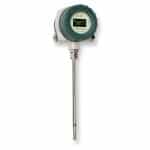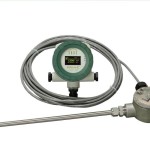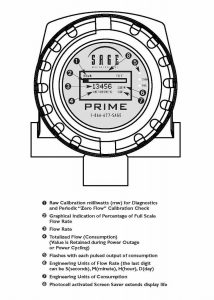The Sage Prime thermal mass flow meter has several features and benefits. This post is a continuation of our user guide series, and it seems appropriate to summarize them here.
Sage Prime for Gases

The Sage Prime is our top-selling thermal mass flow meter which features a bright, high-contrast photo-emissive OLED display. The display clearly states the flow rate, the totalized flow, and temperature and is contained in a robust, yet lightweight, dual-sided NEMA 4 enclosure. The flow rate is also graphically displayed using a horizontal bar graph which shows the percentage of full-scale flow rate. Entirely separated from the electronics in the back is a large, easy-to-access compartment, which has well-marked terminals that permit easy wiring. When powered by 24 VDC (optionally, 12 VDC, or 115/230 VAC), the meter draws less than 2.5 watts, likely making the Prime the most energy-efficient thermal mass flow meter (Draws less than 2.5 watts when under 100 mA at 24 VDC).

The Prime is available in both the SIP Series (integral) and SRP Series (remote). The remote-style meter offers up to 1000 feet of lead-length compensation and an explosion-proof junction box. When ordering, specify any standard probe length or flow body size. The Prime has a 4-20 mA output and a pulsed output of totalized flow (solid-state transistor drive). Also, Sage Prime supports full Modbus® compliant RS485 RTU communications (IEEE 32 bit floating point) and, optionally, HART™ protocol.
Sage Prime is CE approved, and CSA, UL approved for Hazardous Service1 (see “Approvals” under the “Technology” tab on the website).
Continuous Diagnostics & Field Reconfigurability

Although the Sage Prime is fully configured upon shipment for the pipe and process conditions requested by each user, if changes are needed, INSIGHT software is optionally available for field reconfiguration.
In addition to the features and benefits discussed, there are others worthy of mention.
Feature-Benefits of Thermal Mass Flow Meters

The following are generally considered primary features and benefits of thermal mass flow meters.
-
- Direct mass flow – No need for separate temperature or pressure transmitters
- High accuracy and repeatability – Precision measurement and extraordinary repeatability
- Turndown of 100 to 1 and resolution as much as 1000 to 1
- Low-end sensitivity – Measures as low as 5 SFPM (e.g., 1 SCFM in a 6″ pipe)
- Negligible pressure drop – Does not impede the flow or waste energy
- No moving parts – Eliminates costly bearing replacements, and prevents undetected accuracy shifts
- Dirt insensitive – Provides sustained performance
- Ease of installation and convenient mounting hardware
Additional Features Specific to the Sage Prime
In addition to the primary features of the product, and those discussed, Sage Prime offers the following additional features:
-
-
- A compact enclosure; only 4.6″ diameter by 4.5″ deep (DC Models)
- Photocell activated screen saver to extend display life
- Proprietary digital sensor drive circuit provides enhanced signal stability and unaffected by process temperature & pressure changes
- Rugged, user-friendly packaging with easy terminal access
- Option for solar energy use (12 VDC models)
- Flow conditioning built into in-line flow meters (1/2″ and up)
- Captive Flow Conditioners for Insertion meter applications (if required)
-
Other topics from the Sage Prime Manual you many be interested in are:
How to Install and Mount my Sage Prime Thermal Mass Flow Meter?
Flow Profile and Installation Considerations for Insertion Flow Meters
Correction Factors for Biogas Variation From Original Calibration

